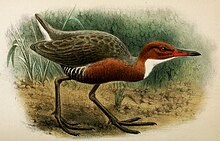| White-throated rail | |
|---|---|

| |
| D. c. cuvieri, Ranomafana National Park | |
| Conservation status | |
 Least Concern (IUCN 3.1) | |
| Scientific classification | |
| Domain: | Eukaryota |
| Kingdom: | Animalia |
| Phylum: | Chordata |
| Class: | Aves |
| Order: | Gruiformes |
| Family: | Rallidae |
| Genus: | Dryolimnas |
| Species: | D. cuvieri |
| Binomial name | |
| Dryolimnas cuvieri (Pucheran, 1845) | |
The white-throated rail (Dryolimnas cuvieri) or Cuvier's rail, is a species of bird in the family Rallidae.
Distribution
It is found in the Comoros, Madagascar, Mayotte, and Seychelles.
Taxonomy

The nominate subspecies is found in Madagascar. A flightless subspecies (sometimes considered a distinct species), Dryolimnas (cuvieri) aldabranus (Aldabra rail), inhabits Aldabra, while the semi-flightless subspecies D. c. Abbott (Assumption rail) from Assumption Island went extinct in the early 20th century due to introduced predators. A fourth extinct flightless subspecies or descendant species is known from fossil remains on Aldabra, and anatomically was almost identical to the Aldabra rail. This subspecies was wiped out by rising sea levels during the Pleistocene, but the atoll was recolonized by the white-throated rail after it resurfaced; this population evolved in a very similar way to the extinct subspecies, eventually evolving into the modern Aldabra rail. This is one of the very few observed instances of iterative evolution, in which a distinct population is wiped out from an area but it is recolonized by members of the source population, who evolve in the same way as the extinct population.
It is now the last living member of the genus Dryolimnas, and the Aldabra subspecies is believed to be the last flightless bird in the Indian Ocean. Its natural habitats are subtropical or tropical moist lowland forest and subtropical or tropical mangrove forest.
References
- BirdLife International (2016). "Dryolimnas cuvieri". IUCN Red List of Threatened Species. 2016: e.T22692535A93357557. doi:10.2305/IUCN.UK.2016-3.RLTS.T22692535A93357557.en. Retrieved 13 November 2021.
- "Seychelles Islands Foundation working to classify Aldabra Rail as a separate species". www.seychellesnewsagency.com. Retrieved 2019-05-11.
- Hume, Julian P. (2017). Extinct Birds. Bloomsbury Natural History. p. 114. ISBN 9781472937445.
- "The bird that came back from the dead". Science Daily.
- Hume, Julian P.; Martill, David (2019). "Repeated evolution of flightlessness in Dryolimnas rails (Aves: Rallidae) after extinction and recolonization on Aldabra" (PDF). Zoological Journal of the Linnean Society. 186 (3): 666–672. doi:10.1093/zoolinnean/zlz018.
- "Seychelles haven of the giant tortoise". 29 May 2018 – via news.bbc.co.uk.
External links
This Gruiformes-related article is a stub. You can help Misplaced Pages by expanding it. |